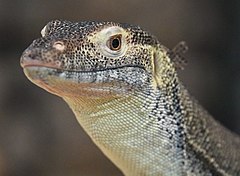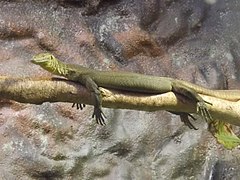
Monitor lizards are lizards in the genus Varanus. They are native to Africa, Asia, and Oceania, and one species is also found in the Americas as an invasive species. About 80 species are recognized.

A goanna is any one of several species of lizards of the genus Varanus found in Australia and Southeast Asia.

The perentie is the largest monitor lizard or goanna native to Australia. It is one of the largest living lizards on earth, after the Komodo dragon, Asian water monitor, crocodile monitor, and intersecting by size with Nile monitor. Found west of the Great Dividing Range in the arid areas of Australia, it is rarely seen, because of its shyness and the remoteness of much of its range from human habitation. The species is considered to be a least-concern species according to the International Union for Conservation of Nature.
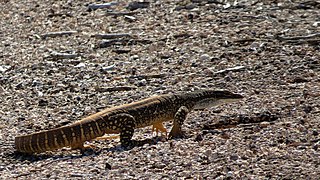
The sand goanna is a species of large Australian monitor lizard, also known as Gould's monitor, sand monitor, or racehorse goanna.

The black tree monitor or Beccari's monitor is a species of lizard in the family Varanidae. The species is a relatively small member of the family, growing to about 90–120 cm (35–47 in) in total length. V. beccarii is endemic to the Aru Islands off New Guinea, living in an arboreal habitat. The skin color of adults is completely black, to which one common name refers.

The mangrove monitor, mangrove goanna, or Western Pacific monitor lizard is a member of the monitor lizard family with a large distribution from northern Australia and New Guinea to the Moluccas and Solomon Islands. It grows to lengths of 3.5 to 4 ft.
The short-tailed pygmy monitor is the second smallest living monitor lizard in the world with a maximum length of 25 cm.

The emerald tree monitor or green tree monitor, is a small to medium-sized arboreal monitor lizard. It is known for its unusual coloration, which consists of shades from green to turquoise, topped with dark, transversedorsal banding. This coloration helps camouflage it in its arboreal habitat. Its color also makes the emerald tree monitor highly prized in both the pet trade and zoos alike.

The yellow-spotted monitor, also known as the Argus monitor, is a monitor lizard found in northern and western regions of Australia and southern New Guinea.

The spiny-tailed monitor, also known as the Australian spiny-tailed monitor, the ridge-tailed monitor or Ackie's dwarf monitor, is an Australian species of lizard belonging to the genus of monitor lizards (Varanus).
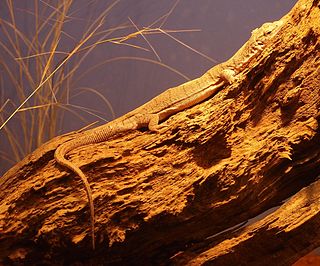
The pygmy mulga monitor, also known as Gillen's monitor or just mulga monitor is a species of lizard in the family Varanidae.

Spencer's goanna, also known commonly as Spencer's monitor, is a species of monitor lizard in the family Varanidae. The species is endemic to Australia.
The Pilbara monitor, also known commonly as Bush's monitor, Bush's pygmy monitor, and the Pilbara mulga goanna, is a species of monitor lizard in the family Varanidae. The species is endemic to Australia.

The Rosenberg's monitor is an Australian species of varanid reptile found in southern regions of the continent. They are large and fast predators with rugged bodies and long tails, having a combined length up to 1.5 metres, that will consume any smaller animal that is pursued and captured or found while foraging. They occur in the Australian Capital Territory, New South Wales, South Australia, Victoria, where it may be rare or locally common, and more frequently observed in Western Australia, where it is sometimes abundant.
The black-spotted ridge-tailed monitor, also called commonly the black-spotted spiny-tailed monitor, the lemon-throated monitor, the northern ridge-tailed monitor, Whites monitor, and the yellow-throated monitor, is a subspecies of lizard in the family Varanidae. The subspecies is native to Australia's tropical Northern Territory. It is listed as Least Concern on the IUCN Red List as it is considered common and not threatened. It was first described in 1987. It is also known as White's dwarf goanna.
The canopy goanna, Keith Horne's monitor, blue-nosed tree monitor, or Nesbit River monitor is a species of monitor lizards native to northeast Australia. It is a member of the Varanus prasinus species group.

Kings' monitor, also known commonly as Kings' goanna, Kings' rock monitor and pygmy rock monitor, is a small species of monitor lizard in the family Varanidae. The species is native to Australia.
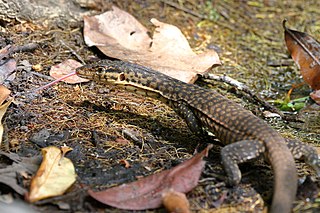
Mitchell's water monitor is a semiaquatic species of monitor lizard in the family Varanidae. The species is native to Australia.
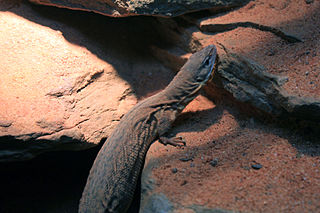
Storr's monitor is a species of monitor lizard in the family Varanidae. The species is endemic to Australia.
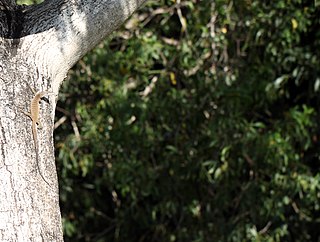
Varanus scalaris is a small species of monitor lizard. It is often referred to as the banded tree monitor or the spotted tree monitor.




